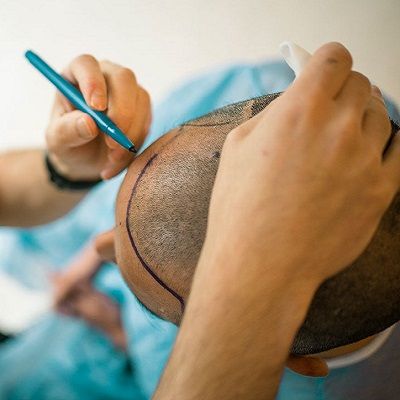
Hair transplants are intended to improve hair growth on the scalp where it has been restricted or nonexistent. They are excellent therapies for various hair loss conditions, but they can prevent future hair loss. People may require follow-up transplants to get long-term effects.
Hair loss and receding hair are natural parts of aging; however, they could also be caused by a medical condition or scalp injury. Some persons who have hair loss might select a hair transplant for aesthetic or therapeutic reasons.
This article examines the chances of success of several hair transplants, how long they last, and any potential adverse effects.
Hair Transplant Types:
Throughout a hair transplant, a doctor would take follicles from a thick hair location, like the side of the head, referred to as the donor area. They then insert the strands into microscopic perforations in the afflicted scalp region.
There are two kinds of hair transplants:
FUSS (Follicular unit strip surgery). A strip of skin will be removed from the donor region, and the cut will be closed with stitches. Next, doctors will use a microscope to split the donor skin into small follicular parts containing one or more hair follicles put into the appropriate location.
FUE (Follicular unit extraction): The doctor will pluck follicles from the donor region using a small punch instrument. While some scarring will occur due to this operation, it’ll be minimally visible, and the client will likely not require sutures.
Both strategies are successful, but in some circumstances, they provide distinct outcomes. According to the researchers, FUE involves more skill and takes more time than FUSS, but it can give excellent results if the surgeon has extensive experience with the method.
Most of the time, surgeons utilize the side or rear of the head as the donor site. Removing skin from the chin, back, or chest, on the other hand, can be helpful. Body hair could be beneficial for persons who lack a thick coat on the front or edges of the head.
According to several studies, collecting body or beard hair is more time-intensive and takes more skill than removing scalp hair. According to another research, the body and beard might be a “great source” of a donor’s hair for hair transplants.
Each treatment takes many hours, based on the number of follicles implanted, and both need a topical anesthetic. On the date of the therapy, a person is generally allowed to go home.
Success Rates:
Hair transplants are successful treatments for regrowing hair after a variety of reasons for hair loss. The effectiveness rate of hair transplant surgery is determined by a variety of factors, such as the surgeon’s expertise and knowledge and the density of the donor’s hair.
According to the American Society of Plastic Surgeons (ASPS), Hair transplantation might result in a bit of an increase in hair volume. May use Skin flap treatment, tissue expansion, or scalp reduction procedures for drastic modifications.
There are no significant studies that provide exact success rates for hair transplants. Several minor studies and papers, on the other hand, give some information concerning the efficacy of these techniques.
According to one study, most participants who had FUE utilizing body or beard hair coupled with scalp hair were happy with the outcomes after an aggregate of 2.9 years of follow-up. The mean total satisfaction level among 79 respondents was 8.3 out of 10.
How long do hair transplants last?
In most situations, a successful hair transplant results in thicker-looking hair. However, they may remain to have thinning hair and loss following the surgery, giving their hair an artificial or uneven look. Individuals may need follow-up transplants for longer-lasting benefits.
As per the ASPS, many of the transplanted hair follicles may fail to “take.” Those follicles expire, and no hair grows to replace them.
Follow your doctor’s post-procedure recommendations for the most significant outcomes. This increases their likelihood of acquiring an effective hair transplant. For many weeks, a person may need to avoid vigorous activities and exercise. They might have to wait just a few days until shampooing their hair as well.
Adverse consequences:
According to the experts, the best hair specialists will perform hair treatments with safety and precision. Even with effective hair transplants, specific adverse effects may occur.
Bleeding or infection:
Hair transplant surgery entails creating wounds or cuts inside the skin. A doctor cuts the scalp to retrieve the donor follicles and microscopic scratches to insert the strands. Any cut carries the danger of illness or severe bleeding.
Scars:
Scarring on all the donor sites and the transplant location is also a possibility. While deciding to get the treatment, a person must discuss the hazards with their physician.
The FUSS procedure typically results in a lengthy, linear incision where the doctor excises a piece of scalp. As new hair comes in around the scar, this could become concealed. It may be apparent, though, if it widens during healing, the adjoining hair is sparse, or the individual maintains it short in style.
The FUE treatment may cause minor scars in the region in which the follicles were extracted with the punch instrument by the doctor. These scars, though, may not be as extensive as the FUSS scar.
An individual may develop raised pimples surrounding the transplanted hair in some circumstances. These pimples may be hidden when the hair comes back.
Swelling and pain:
Some patients may suffer discomfort while their skin heals following the operation. To aid with this, their surgeon may prescribe pain medicines. As the skin heals, it may experience some inflammation in the neck and head.
Final Words!
Hair transplant treatment could be a suitable choice for persons who are experiencing hair reduction or loss. Although it is not a lasting cure for thinning hair, it can help restore hair fullness and self-confidence in many people.
During the appointment, you and the physician must examine your objectives and desires, the number of follicular units needed to accomplish the appropriate coverage, and the finalization of the hairline. It will assist you and the doctor in determining the optimal technique of hair transplantation for you.











